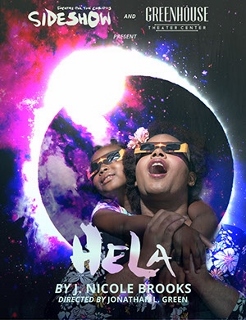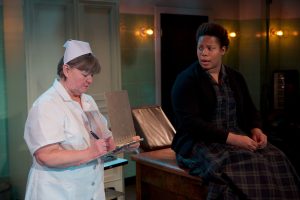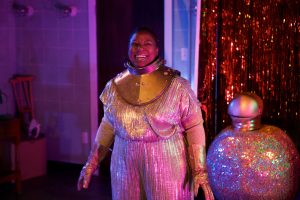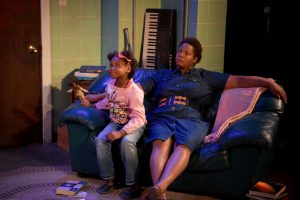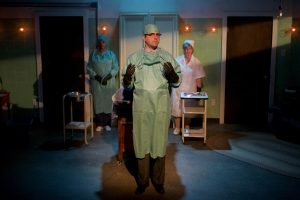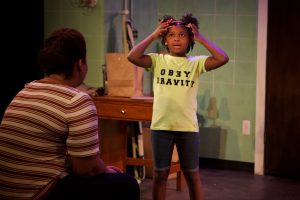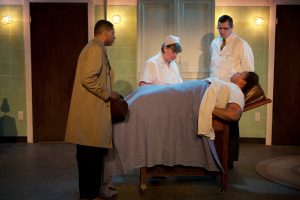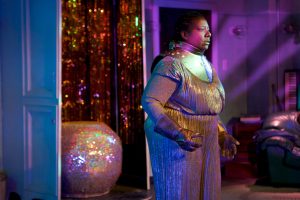FROM CANCER TO THE COSMOS,
OR TO HELA AND BACK
There’s cold fusion and then there’s hot fusion–the theatrical kind. In the world-premiere HeLa, an awesome co-production by Sideshow Theatre Company and Greenhouse Theater Center, it forges its own supernova of discoveries. In 150 truth-packed minutes, playwright J. Nicole Brooks manages to connect a medical miracle from 1951, a 1980 P.B.S. astronomy series, a little girl’s science project, an eclipse seen from Chicago’s Adler Planetarium, and a space/time traveler who discovers the loneliness of being ahead of, well, everything.
In this play the sky is not the limit!
With Jonathan L. Green’s supple and mercurial staging, seven wonderful actors enact three stories of African-Americans — in love and in science — that dovetail and crystallize. Cunningly detailed though collectively scattershot, Brooks’s mortar-and-pestle talespinning never quite yields a whole that’s greater than its parts. But it delivers a trio of alternating and interconnected scenarios, each more intriguing than most full-length plots. The ingredients are wonderful even if the recipe is less.
The initial action happens in set designer Yu Shibagaki’s multi-purpose basement on Chicago’s West Side. Here a little girl (marvelous Ayah Sol Masai Hall) watches the late Carl Sagan’s famous Cosmos space-logue — and her imagination takes flight like an interplanetary probe. Above the little girl’s astral projections surges a Whist-playing party. Soon she’s visited by her protective Auntie Bird (Nicole Michelle Haskins), a surrogate mother for one who died too soon. Bird adores her “badass bookworm,” who’s equally encouraged by Bird’s amiable boyfriend Steve (avuncular David Lawrence Hamilton) and nice-neighbor Big Titty Pat (bumptious Carolyn Nelson).
Their conversation overflows with free-floating speculations about the difference between meteors, meteorites and meteoroids, gold falling from the skies, Afrocentric legends of exploration, and the stages of star formation (presented by the Little Girl with promptings to project from her doting auntie). This section blossoms to disclose a marriage proposal during a solar eclipse and the final fulfillment of the little girl’s astronautical aspirations.
Much, much less earthbound, the second storyline exposés Jata (magnificent Deanna Reed-Foster). Emerging from a cupboard much like the one containing Narnia, Jata is a tough-talking voyager in a gold-plated UFO from the distant future. Passing a ton of time, she comments on the quirky blue planet she left behind. Lost in space, Jata later meets another lonely traveler (Matt Fletcher). Based on David Bowie’s 1969 astronaut “Major Tom,” he shares her awe over passing supernovas, star clusters, constellations, pulsars, and the sheer blackness of dark matter.
Most intriguing is the central and founding “storyboard” that supports the other two — and this one is a true tale. It chronicles the amazing and unwitting contribution of Henrietta Lacks, an African-American mother of five (Haskins) who died of cancer of the cervix in 1951. Conveying the forced anonymity of “Woman,” as she’s listed in the program, her name is garbled until the end: Then Henrietta can finally, if posthumously, claim her fame.
Green’s inspiration stems, so to speak, from a set of seemingly indestructible cancer cells harvested from Henrietta Lacks by Johns Hopkins’ “Colored Gynecology” ward in Baltimore. Now called the HeLa Code, they are virtually immortal, the first human cells to both multiply rapidly and to survive in vitro. Repeated cell divisions cannot exhaust their multifaceted capacities: Henrietta’s constant creations can stay alive long enough for the most painstaking chromosomal research.
Taken without the patient’s consent (or the surviving family’s compensation), Henrietta’s remarkable line of prolific and durable tissue is the ultimate gift that keeps on giving. Her death yielded an unprecedented boon and blessing — to medicine (the polio vaccine and disease research on radiation and toxic effects) and even studies of human sensitivity to cosmetics, tape and glue. In all, 50 tons of Henrietta’s curative cells have been harvested and 11,000 patents issued, based on their benevolence!
Throughout HeLa, Henrietta’s unrequited legacy of miracle cures pulsates with promise. We feel it, thirty years late, in the Little Girl’s cosmic curiosity. It culminates in the intrepid Jata’s intergalactic odyssey. The latter character, embodying the final evolution of Henrietta’s Promethean-like offering, is inspired by a kind of other-worldly apotheosis: Henrietta’s supercells have been launched into orbit on space missions (and even blown up by an atomic bomb). H.L. becomes the unintentionally altruistic avatar who lifts every character into orbit.
So does the director, Mr. Green, whose septet performs their own wonders in a densely imagined, if roughly hewn, new play. Special praise goes to the indomitable Ms. Haskins: Her wonderful range — from the confused and challenged “Woman” to the more-than-maternal Auntie Bird — is a five-star labor of love.
Up, up, and beyond!
photos by Jonathan L. Green
HeLa
Sideshow Theatre and Greenhouse Productions
Greenhouse Theater Center, 2257 N. Lincoln Ave.
Thurs-Sat at 7:30; Sun at 2:30
(dark Nov. 22 and Nov. 24 at 7:30; add’l matinee Nov. 24 at 2:30)
ends on December 23, 2018
for tickets, call 773.404.7336 or visit Greenhouse
for more shows, visit Theatre in Chicago
